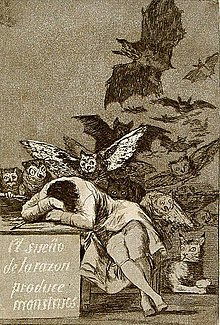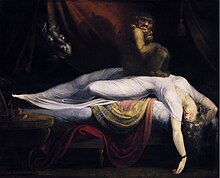Nightmare: Difference between revisions
m Moved Further reading below Refs per MoS. |
Added 1 image. |
||
| Line 1: | Line 1: | ||
{{Hatnote|Not to be confused with [[Night terror]]. For other uses, see [[Nightmare (disambiguation)]].}} |
{{Hatnote|Not to be confused with [[Night terror]]. For other uses, see [[Nightmare (disambiguation)]].}} |
||
{{Merge from|Treating nightmares|date=August 2011}} |
{{Merge from|Treating nightmares|date=August 2011}} |
||
[[File:Capricho 43, El sueño de la razón produce monstruos.jpg|thumb|right|''[[The Sleep of Reason Produces Monsters]]'' ([[Francisco de Goya]], c.1797)]] |
|||
| ⚫ | |||
A '''nightmare''' is an unpleasant [[dream]] that can cause a strong negative emotional response from the mind, typically [[fear]] or [[horror and terror|horror]], but also [[despair (emotion)|despair]], [[anxiety]] and great [[sadness]]. The dream may contain situations of danger, discomfort, psychological or physical terror. Sufferers usually awaken in a state of distress and may be unable to return to [[sleep]] for a prolonged period of time.<ref>American Psychiatric Association (2000), Diagnostic and Statistical Manual of Mental Disorders, 4th ed, TR, p. 631</ref> |
A '''nightmare''' is an unpleasant [[dream]] that can cause a strong negative emotional response from the mind, typically [[fear]] or [[horror and terror|horror]], but also [[despair (emotion)|despair]], [[anxiety]] and great [[sadness]]. The dream may contain situations of danger, discomfort, psychological or physical terror. Sufferers usually awaken in a state of distress and may be unable to return to [[sleep]] for a prolonged period of time.<ref>American Psychiatric Association (2000), Diagnostic and Statistical Manual of Mental Disorders, 4th ed, TR, p. 631</ref> |
||
==Overview== |
==Overview== |
||
| ⚫ | |||
Nightmares can have [[Human body|physical]] causes such as sleeping in an uncomfortable or awkward position, having a fever, or psychological causes such as [[stress (medicine)|stress]] and [[anxiety]] or [[death]]. Eating before going to sleep, which triggers an increase in the body's metabolism and brain activity, is a potential stimulus for nightmares.<ref name=Stephens>{{cite journal |author=Stephens, Laura |title=Nightmares :) |journal=Http://web.archive.org/web/20070831193305/http://www.psychologytoday.com/conditions/nightmare.html |year=2006}}</ref> |
Nightmares can have [[Human body|physical]] causes such as sleeping in an uncomfortable or awkward position, having a fever, or psychological causes such as [[stress (medicine)|stress]] and [[anxiety]] or [[death]]. Eating before going to sleep, which triggers an increase in the body's metabolism and brain activity, is a potential stimulus for nightmares.<ref name=Stephens>{{cite journal |author=Stephens, Laura |title=Nightmares :) |journal=Http://web.archive.org/web/20070831193305/http://www.psychologytoday.com/conditions/nightmare.html |year=2006}}</ref> |
||
Revision as of 03:42, 30 March 2012
It has been suggested that Treating nightmares be merged into this article. (Discuss) Proposed since August 2011. |

A nightmare is an unpleasant dream that can cause a strong negative emotional response from the mind, typically fear or horror, but also despair, anxiety and great sadness. The dream may contain situations of danger, discomfort, psychological or physical terror. Sufferers usually awaken in a state of distress and may be unable to return to sleep for a prolonged period of time.[1]
Overview

Nightmares can have physical causes such as sleeping in an uncomfortable or awkward position, having a fever, or psychological causes such as stress and anxiety or death. Eating before going to sleep, which triggers an increase in the body's metabolism and brain activity, is a potential stimulus for nightmares.[2]
Recurrent nightmares that can interfere with sleeping patterns and cause insomnia may require medical help.
Etymology
"Nightmare" evokes the modern word for a female horse but the terms are wholly unrelated. The word derives from the Old English "mare", a mythological demon who torments human beings with frightening dreams.[3]
Medical investigation
Studies of dreams have estimated that about 75% of dream content or emotions are negative.[4]
One definition of "nightmare" is a dream which causes one to wake up in the middle of the sleep cycle and experience a negative emotion, such as fear. This type of event occurs on average once per month. They are not common in children under 5, but they are more common in young children (25% experiencing a nightmare at least once per week), most common in teenagers, and less common in adults (dropping in frequency about one third from age 25 to 55).[4]
Fearfulness in waking life is correlated with the incidence of nightmares.[4]
Treatment
Both Freud and Jung seemed to have shared a common understanding that people frequently distressed by nightmares could be re-experiencing some stressful event from the past.[5] Both perspectives on dreams suggest that therapy can provide relief from the dilemma of the nightmare experience.
Treatment theories
Halliday (1987) grouped treatment techniques into four classes. Direct nightmare interventions that combine compatible techniques from one or more of these classes may enhance overall treatment effectiveness:[6]
- analytic and cathartic techniques
- story-line alteration procedures
- face-and-conquer approaches
- desensitization and related behavioral techniques
Other treatment techniques
Recurring post-traumatic stress disorder nightmares in which real traumas are re-experienced respond well to a technique called imagery rehearsal. First described in the 1996 book Trauma and Dreams[7] by Harvard psychologist Deirdre Barrett, this contemporary dream interpretation involves the dreamer coming up with an alternate, mastery outcome to the nightmare, mentally rehearsing that outcome awake, and then reminding themselves at bedtime that they wish this alternate outcome should the nightmare recur. Research has found that this technique not only reduces the occurrence of nightmares and insomnia,[8] but also improves other daytime PTSD symptoms.[9]According to Bret Moore and Barry Krakow, the most common variations of Imagery Rehearsal Therapy (IRT) "relate to the number of sessions, duration of treatment, and the degree to which exposure therapy is included in the protocol".[10] Another kind of treatment not only helping the reduction of nightmares, sleep disturbance, and other PTSD symptoms is prazosin. There have been multiple studies conducted under the placebo controlled study team. (Am J Psychiatry 2003; 160:371–373)
- "A comprehensive model has been put forth by Krakow and Zadra (2006) that includes four group treatment sessions, ~2.25 to 2.5 hr in length. The first two sessions focus on how nightmares are closely connected to insomnia and how they become an independent symptom or disorder that warrants individually tailored and targeted intervention. The last two sessions focus on the imagery system and how IRT can reshape and eliminate nightmares through a relatively straightforward process akin to cognitive restructuring via the human imagery system. First, the patient is asked to select a nightmare, but for learning purposes the choice would not typically be one that causes a marked degree of distress. Second, and most commonly, guidance is not provided on how to change the disturbing content of the dream; the specific instruction developed by Joseph Neidhardt is “change the nightmare anyway you wish” (Neidhardt et al., 1992). In turn, this step creates a “new” or “different” dream, which may or may not be free of distressing elements. Our instructions, unequivocally, do not make a suggestion to the patient to make the dream less distressing or more positive or to do anything other than “change the nightmare anyway you wish.” Last, the patient is instructed to rehearse the “new dream” through imagery and to ignore the old nightmare."[10]
See also
- False awakening
- Hag in folklore
- Lucid dream
- Mare (folklore)
- Mora (mythology)
- Moroi (folklore)
- Night terror
- Nightmare disorder
- Nocnitsa
- Sleep disorder
- Sleep paralysis
References
- ^ American Psychiatric Association (2000), Diagnostic and Statistical Manual of Mental Disorders, 4th ed, TR, p. 631
- ^ Stephens, Laura (2006). "Nightmares :)". Http://web.archive.org/web/20070831193305/http://www.psychologytoday.com/conditions/nightmare.html.
{{cite journal}}: External link in|journal= - ^ Liberman, Anatoly (2005). Word Origins And How We Know Them. Oxford: Oxford University Press. p. 87. ISBN 9780195387070. Retrieved 29 March 2012.
- ^ a b c The Science Behind Dreams and Nightmares, Talk of the Nation, national Public Radio. 30 October 2007.
- ^ Coalson 1985, Web
- ^ Halliday 1987
- ^ ISBN 0674006909
- ^ Attention: This template ({{cite doi}}) is deprecated. To cite the publication identified by doi:10.1207/s15402010bsm0303_3, please use {{cite journal}} (if it was published in a bona fide academic journal, otherwise {{cite report}} with
|doi=10.1207/s15402010bsm0303_3instead. - ^ Attention: This template ({{cite doi}}) is deprecated. To cite the publication identified by doi:10.1001/jama.286.5.537, please use {{cite journal}} (if it was published in a bona fide academic journal, otherwise {{cite report}} with
|doi=10.1001/jama.286.5.537instead. - ^ a b Attention: This template ({{cite doi}}) is deprecated. To cite the publication identified by doi:10.1002/jts.20407, please use {{cite journal}} (if it was published in a bona fide academic journal, otherwise {{cite report}} with
|doi=10.1002/jts.20407instead., p. 234 Cite error: The named reference "pmid19444882" was defined multiple times with different content (see the help page).
Further reading
- Anch, A. M., Browman, C.P., Mitler, M.M., & Walsh, J.K., Sleep: A scientific perspective (New Jersey: Prentice-Hall, 1988).
- J.-M. Husser et A. Mouton (Éd.), Le Cauchemar dans les sociétés antiques. Actes des journées d'étude de l'UMR 7044 (15-16 Novembre 2007, Strasbourg) (Paris, De Boccard, 2010).
- Harris J.C. (2004). Arch Gen Psychiatry. May;61(5):439-40. The Nightmare. (PMID 15123487)
- Jones, Ernest (1951). On the Nightmare (ISBN 0-87140-912-7) (pbk, 1971; ISBN 0-87140-248-3).
- Forbes, D. et al. (2001) Brief Report: Treatment of Combat-Related Nightmares Using Imagery Rehearsal: A Pilot Study, Journal of Traumatic Stress 14 (2): 433-442
- Siegel, A. (2003) A mini-course for clinicians and trauma workers on posttraumatic nightmares.
- Burns, Sarah (2004). Painting the Dark Side : Art and the Gothic Imagination in Nineteenth-Century America. Ahmanson-Murphy Fine Are Imprint, 332 pp., University of California Press, ISBN 0-520-23821-4.
- Davenport-Hines, Richard (1999). Gothic: Four Hundred Years of Excess, Horror, Evil and Ruin. North Point Press, p. 160-61.
- Hill, Anne (2009). What To Do When Dreams Go Bad: A Practical Guide to Nightmares. Serpentine Media, 68 pp., ISBN 1-887590-04-8
- Simons, Ronald C and Hughes, Charles C (eds.) (1985). Culture-Bound Syndromes. Springer, 536 pp.
- Sagan, Carl (1997). The Demon-Haunted World: Science as a Candle in the Dark.
- Coalson, Bob. "Nightmare help: Treatment of trauma survivors with PTSD." Psychotherapy: Theory, Research, Practice, Training 32.3 (1995): 381-388. PsycARTICLES. EBSCO. Web. 18 Mar. 2011.
- Collins, Suzanne. The Hunger Games. New York: Scholastic, 2008.
- "Dreams - Practical Dream Analysis & Waking Life Meaning." Dream Interpretation, Psychology & Research, Nightmares & Alternative Medicine. Dreams Foundation, 1996. Web. 19 Jan. 2011. <http://www.nightmares.info/nightmares.htm>.
- Halliday, G. (1987). “Direct psychological therapies for nightmares: A review.” Clinical Psychology Review, 7, 501–523.
- "Imagery Rehearsal Therapy (IRT)." The Encyclopedia of Trauma and Traumatic Stress Disorders. Ronald M. Doctor and Frank N. Shiromoto. New York: Facts on File, 2010. 148. Gale Virtual Reference Library. Web. 21 Feb. 2011.
- Mayer, Mercer. There's a Nightmare in My Closet. [New York]: Puffin Pied Piper, 1976.
- Moore, Bret A., and Barry Kraków. "Imagery rehearsal therapy: An emerging treatment for posttraumatic nightmares in veterans." Psychological Trauma: Theory, Research, Practice, and Policy 2.3 (2010): 232-238.
External links
- The value of nightmares and common nightmare themes
- Night-Mares: Demons that Cause Nightmares
- Elements of the Nightmare
- Gothic Nightmares exhibit
- Nightmare
